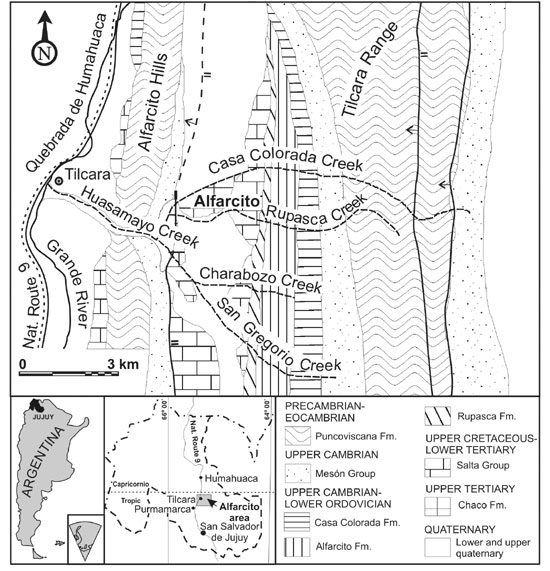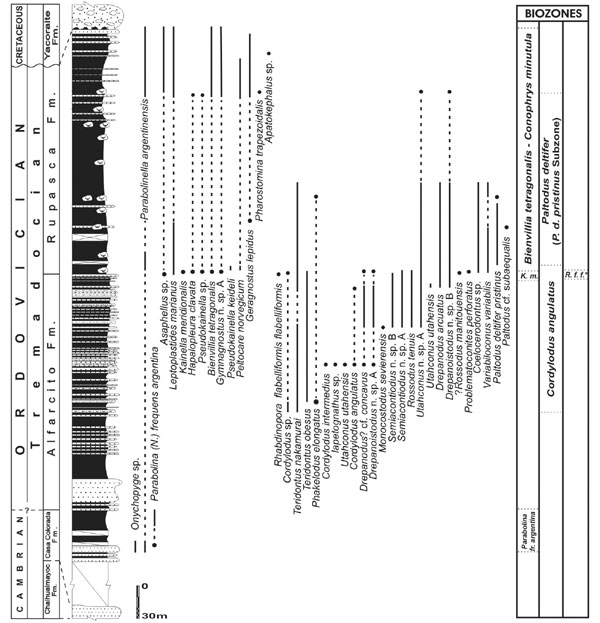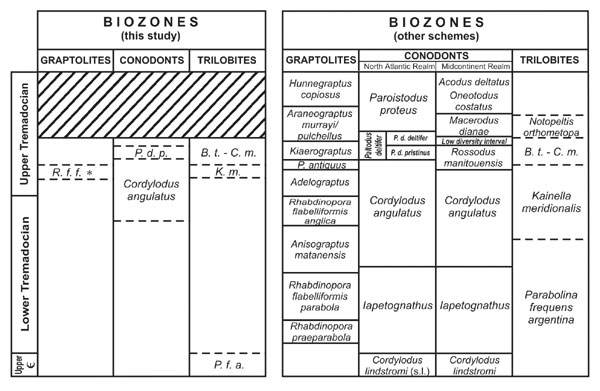
Biostratigraphy of Ordovician sequences from Alfarcito area, Tilcara, Eastern Cordillera of Jujuy, Argentina
Fernando J. Zeballo1, Guillermo L. Albanesi2, Gladys Ortega2 and Franco Tortello3
1 Museo de Paleontología, FCEFyN, Universidad Nacional de Córdoba, Av. Vélez Sarsfield 299, 5000 Córdoba.
2 CONICET – Museo de Paleontología, FCEFyN, Universidad Nacional de Córdoba, Av. Vélez Sarsfield 299, 5000 Córdoba. E–mail: galbanesi@arnet.com.ar / gortega@arnet.com.ar
3 CONICET – Departamento de Paleontología de Invertebrados, Museo de Ciencias Naturales, Paseo del Bosque s/n, 1900 La Plata. E–mail: tortello@infovia.com.ar
Key words: Biostratigraphy. Lower Ordovician. Alfarcito area. Eastern Cordillera. Argentina.
Introduction
Present study is aimed to propose a comprehensive biostratigraphy and correlation of Lower Paleozoic sequences cropping out in the Alfarcito area of Eastern Cordillera, North–western Argentina.
Previous paleontological works from these sequences were devoted to trilobites (Harrington and Leanza, 1957). Subsequently, López and Nullo (1969) presented the geology of the area, and Moya (1988) described the stratigraphy of the Rupasca Creek, among other Lower Ordovician sections of Eastern Cordillera.
About 400 trilobite samples, 57 graptolite samples, and 23 carbonate samples for conodonts (ca. 2 kg each, on average, yielding 3000 elements in total) were collected from the whole Cambro–Ordovician succession, allowing for the proposal of a composite biostratigraphic scheme. Registered conodonts show a Color Alteration Index 3 that corresponds to 110º–200º overburden paleotemperatures (Epstein et al., 1977). Fossil materials are deposited in the Paleontological Museum, National University of Córdoba (under CORD–MP and CORD–PZ repository abbreviations).
Authors acknowledge supports by CONICET and National University of Córdoba, Argentina, for current research.
Location and stratigraphical framework of the study area
The Alfarcito area is located to the east of Tilcara City in the eastern borderland of Eastern Cordillera. Tilcara is situated 85 km to the north of Jujuy City driving along National Route Nº 9. Two sections from the Alfarcito area; i.e, Casa Colorada and San Gregorio creeks, were surveyed. These creeks drain into the Huasamayo River, which in turn drains into the Grande River, Quebrada de Humahuaca. Casa Colorada locality is reached from Tilcara by the road that crosses over the Garganta del Diablo Pass and the Alfarcito Valley (ca. 12 km from Tilcara). San Gregorio section is located to the south of Casa Colorada, midway to Yakipampa.

Figure 1. Geologic map of the Alfarcito area (modified after López and Nullo, 1969 and Mon et al., 1993).
The Casa Colorada, Alfarcito, and Rupasca formations (Harrington and Leanza, 1957) are made up of mostly siliciclastic rocks. The upper part of the Casa Colorada Formation (50 m thick) is composed by dark–gray shales with interbedded sandstones. The Alfarcito Formation (210 m thick) is a heterolithic succession of sandstones and shales with interbedded limestones, and the Rupasca Formation (225 m thick) consists of dark–gray shales bearing abundant fossiliferous concretions. The stratigraphic succession is N–S trending and dips about 60º to the W; in particular, the Alfarcito Formation is faulted and folded in its lower part at Casa Colorada Creek.
Sedimentology, lithologic and taphonomic features indicate an outer shelf, under euxinic depositional environments, for the Casa Colorada Formation. A shallowing upwards sequence that occasionally reaches intertidal settings characterizes the Alfarcito Formation, which is separated by a sequence boundary from the overlying Rupasca Formation. The transgressive succession of the latter formation is mostly deposited under low oxygen conditions.
Biostratigraphy
Registered trilobites are Parabolina frequens argentina, Onychopyge sp., Parabolinella argentinensis, Asaphellus sp., Leptoplastides marianus, Kainella meridionalis, Hapalopleura clavata, Pseudokainella keideli, Pseudokainella sp., Bienvillia tetragonalis, Peltocare norvegicum, Pharostomina trapezoidalis, Apatokephalus sp., Geragnostus lepidus, and Gymnagnostus n. sp. A. They represent the Parabolina frequens argentina Zone in the uppermost part of Casa Colorada Formation, Kainella meridionalis Zone in the lowermost part of Rupasca Formation and Bienvillia tetragonalis–Conophrys minutula Zone in the rest of same formation.

Figure 2. Composite column of the Alfarcito area showing species ranges, trilobite and conodont biozones, and graptolite ionterval. (Abbr.: K. m.: Kainella meridionalis Zone, R. f. f.: interval with Rabhdinopora flabelliformis flabelliformis).

Figure 3. Biostratigraphic scheme from this study (left) and other authors (right) (Cooper, 1999; Löfgren, 1997; Harrington and Leanza, 1957; Mota et al., 1994; Tortello and Rao, 2000; Ortega and Albanesi, 2002. Abbr.: P.f.a.: Parabolina frecuens argentina, K.m.: Kainella Meridionalis, B.t. – C.m.: Bienvillina tetragonalis Conophrys minutula, P.d.p.: Paltodus deltifer pristinus, R.f.f.*: Interval with Rhabdinopora fabelliformis fabelliformis).
The conodont fauna is composed of Cordylodus angulatus, C. intermedius, Cordylodus sp., Iapetognathus sp., Teridontus nakamurai, T. obesus, Utahconus utahensis, Drepanodus? cf. concavus, Monocostodus sevierensis, Rossodus tenuis, ?R. manitouensis, Variabiloconus variabilis, Paltodus deltifer pristinus, Paltodus cf. subaequalis, Coelocerodontus sp., and species of paraconodonts and protoconodonts, such as Problematoconites perforatus and Phakelodus elongatus. Five new species are defined: Drepanoistodus n. sp. A and B, Semiacontiodus n. sp. A and B, and Utahconus n. sp. A. The assemblage corresponds to the Cordylodus angulatus Zone that ranges from the middle part of Alfarcito Formation to the lowermost part of Rupasca Formation, and Paltodus deltifer Zone (Paltodus deltifer pristinus Subzone) in the lower to middle part of same formation.
The record of the graptolite Rhabdinopora flabelliformis flabelliformis defines a brief interval in uppermost part of the Alfarcito Formation.
The association of Parabolina frequens argentina and Onychopyge sp. suggests a latest Cambrian age for the upper part of the Casa Colorada Formation. The conodont assemblage, characterized by Rossodus tenuis and Cordylodus angulatus, indicates an early Tremadocian age for the Alfarcito Formation. The presence of Paltodus deltifer pristinus, P. cf. subaequalis, and Variabiloconus variabilis, together with Peltocare norvegicum suggests an early Late Tremadocian age for the Rupasca Formation. The occurrence of Rhabdinopora flabelliformis flabelliformis, 10 m below Paltodus deltifer Zone, in association with Kainella meridionalis, points out a younger record for the graptolite species.
The trilobite association shows Atlantic affinities, including endemic forms that correspond to the Baltic Province (cold–0water) of Shergold’s scheme (1988). The conodont fauna, which is similar to that one studied by Rao and Tortello (1998) from Incamayo Creek, Eastern Cordillera, corresponds to the Transitional Faunal Realm (with taxa from both the North Atlantic and Midcontinent realms) defined by Dubinina (1991) for low– to mid–paleolatitude settings.
References
Cooper, R.A. 1999. Ecostratigraphy, zonation and global correlation of earliest Ordovician planktic graptolites. Lethaia, 32: 1–16.
Dubinina, S.V. 1991. Upper Cambrian and Lower Ordovician conodont associations from open ocean paleoenvironments, illustrated by Batyrbay and Sarykum sections in Kazakhstan. In: Barnes, C. R. y Williams, S. H. (Eds.). Advances in Ordovician Geology. Geological Survey of Canada, Paper 90–9: 107–124.
Epstein, A.G., Epstein, J.B. and Harris, L.D. 1977. Conodont color alteration – An index to organic metamorphism. United States Geological Survey Professional Paper, 995: 1–27.
Harrington, H.J. and Leanza, A.F. 1957. Ordovician trilobites of Argentina. Department of Geology, University of Kansas. Special Publication 1: 276.
Löfgren, A. 1997. Conodont faunas from the upper Tremadoc at Brattefors, south–central Sweden, and reconstruction of the Paltodus apparatus. Geologiska Föreningens i Stockholm Förhandlingar, 119: 257–266.
López, C.R. and Nullo, F.E. 1969. Geología de la margen izquierda de la quebrada de Humahuaca, de Huacalera a Maimará, Departamento Tilcara, Provincia de Jujuy, República Argentina. Revista de la Asociación Geológica Argentina, 24 (3): 173–182.
Mon, R., Rahmer, S. and Mena, R. 1993. Estructuras superpuestas en la Cordillera Oriental, Provincia de Jujuy, Argentina. 12º Congreso Geológico Argentino y 2º Congreso de Exploración de Hidrocarburos, Actas 3: 48–54.
Moya, M.C. 1988. Estratigrafía del Tremadociano en el tramo austral de la Cordillera Oriental argentina. Tesis doctoral. Facultad de Ciencias Naturales, Universidad Nacional de Salta, 1–368 (unpublished).
Moya, M.C., Malanca, S., Monteros, J.A. and Cuerda, A. 1994. Bioestratigrafía del Ordovícico inferior en la Cordillera Oriental argentina basada en graptolitos. Revista Española de Paleontología, 9 (1): 91–104.
Ortega, G. and Albanesi, G.L. 2002. Bioestratigrafía de graptolitos y conodontes del Tremadociano tardío de la Cordillera Oriental argentina. XV Congreso Geológico Argentino, El Calafate, I: 542–547.
Rao, R.I. and Tortello, M.F., 1998. Tremadoc conodonts and trilobites from the Cardonal Formation, Incamayo creek, Salta Province, northwestern Argentina. In: Szaniawski, H. (Ed.), Palaeontologia Polonica, Warszawa, 58: 31–45.
Shergold, H.J. 1988. Review of trilobite biofacies distributions at the Cambrian–Ordovician Boundary. Geological Magazine, 125 (4): 363–380.
Received: February 15, 2003
Accepted: June 15, 2003